Browse All Articles > SQL Server Replication - Transactional Replication type step by step
In previous article, I talked about basic concepts and terms of replication using SQL Server. Now, we're going to investigate one of replication types that is called transactional replication. How do we configure this type? When will we use it?
The Log Reader Agent scans the transaction log of the publication database and examines each committed transaction to determine whether any changes affect the replicated articles. If they do, those changes are logged to the distribution database. The Distribution Agent then replicates those changes to the Subscriber (source: Microsoft TechNet).
![Transactional-Replication.gif]()
![TransactionalReplication.png]()
![Distributor1.png]() 2- Since Distributor and Publisher are on the same server, we will choose the current server-> Next
2- Since Distributor and Publisher are on the same server, we will choose the current server-> Next
![Distributor2.png]() 3- Choose No, I will start SQL Server Agent service manually -> Next
3- Choose No, I will start SQL Server Agent service manually -> Next
4- Enter folder for Snapshot folder. This folder will be used for Snapshot Replication type->Next![Distributor3.PNG]() 5- Enter Distributor name, folder to store Distribution Database file and log file -> Next
5- Enter Distributor name, folder to store Distribution Database file and log file -> Next
![Distributor4.PNG]() 6- Add current server as Publisher
6- Add current server as Publisher
7- Finish
![Distributor5.PNG]() Now, you can see Distribution Database in the System Databases folder
Now, you can see Distribution Database in the System Databases folder
![Distributor7.PNG]()
![Distributor8.PNG]() 2- Choose the transaction publication type
2- Choose the transaction publication type
![Distributor9.PNG]() 3- Choose tables, views or objects need to been replicated. Somtimes, there is an error message if your tables do not have PRIMARY KEY
3- Choose tables, views or objects need to been replicated. Somtimes, there is an error message if your tables do not have PRIMARY KEY
![Distributor10.PNG]() 4-Choose Create snapshot immediately and keep the snapshot available to initialize subscriptions
4-Choose Create snapshot immediately and keep the snapshot available to initialize subscriptions
![Distributor11.PNG]() 5- Snapshot Agent Security -> Use SQL Server Agent service account, depending on your requirements. This option is not recommended; you should use the domain Window account as best practice -> Next
5- Snapshot Agent Security -> Use SQL Server Agent service account, depending on your requirements. This option is not recommended; you should use the domain Window account as best practice -> Next
![Distributor12.PNG]() 6- Enter publication name Sales_Retail
6- Enter publication name Sales_Retail
![Distributor13.PNG]() 7- Finish
7- Finish
![Distributor14.PNG]() 8- Expand Local Publication folder, you can see the new publication which was just created.
8- Expand Local Publication folder, you can see the new publication which was just created.
![Distributor15.PNG]()
1- Connect to the SQLServer2008R2 Instance, expand Replication folder, right-clik on Local Subscriptions and create New Subscriptions -> Next
2- Find SQL Server Publisher -> Connect to the publisher that was created on SQLServer2012 -> Next
![Distributor16.png]() 3- Choose the Distribution Agent Location. Depending on your system, you determine on which server to run the agents. For the desmontration purposes, I chose Run all agents at the Distributor, meaning that all agents will run on SQLServer2012.
3- Choose the Distribution Agent Location. Depending on your system, you determine on which server to run the agents. For the desmontration purposes, I chose Run all agents at the Distributor, meaning that all agents will run on SQLServer2012.
![Distributor17.PNG]() 4- Choose Subscription Database Sales_Retail. If the database does not exist, you can use above script to create it.
4- Choose Subscription Database Sales_Retail. If the database does not exist, you can use above script to create it.
![Distributor18.PNG]() 5- Distribution Agent Security -> Choose to use SQL Server Agent service account (not recommend)
5- Distribution Agent Security -> Choose to use SQL Server Agent service account (not recommend)
![Distributor19.PNG]()
6- Synchronization Schedule. You can schedule to synchronize data using
![Distributor20.png]()
7- Finish
![Distributor21.PNG]()
8- Query the data from OrderDetail table on SQLServer2008R2. There are two rows:
![Distributor22.PNG]() We will insert two new rows into OrderDetail table on SQLServer2012 and re-run replication job to see the result.
We will insert two new rows into OrderDetail table on SQLServer2012 and re-run replication job to see the result.
Expand Local Publication-> right-click Sales_Retail publication database -> Reinitialize. After that, query data from OrderDetail table on SQLServer2008R2 again. The result is there is 4 rows (two new rows inserted).
Transaction Replication is appropriate in each of the following cases:
However, whenever you want to use Transaction Replication you should consider some factors:
Definition and mechanism
Transactional replication copies data uni-directionally from the source database to the target database. This replication type uses the log files associated with the source database to keep data in sync. If a change is made to the source database, that change can be synched to the target database immediately, or the synchronization can be scheduled.The Log Reader Agent scans the transaction log of the publication database and examines each committed transaction to determine whether any changes affect the replicated articles. If they do, those changes are logged to the distribution database. The Distribution Agent then replicates those changes to the Subscriber (source: Microsoft TechNet).

Transactional Replication Configuration
As you know, replication architecture has three components: Publisher, Distributor and Subscriber that we need to configure.Scenario
In a retail environment, management wants to know how many items are sold hourly. To avoid impacting the Sales database, they process reports and statistics on another server.Architecture
Basically, we put Publisher and Distributor on the same SQLServer2012 Instance and Subscriber on another SQLServer 2008R2 Instance.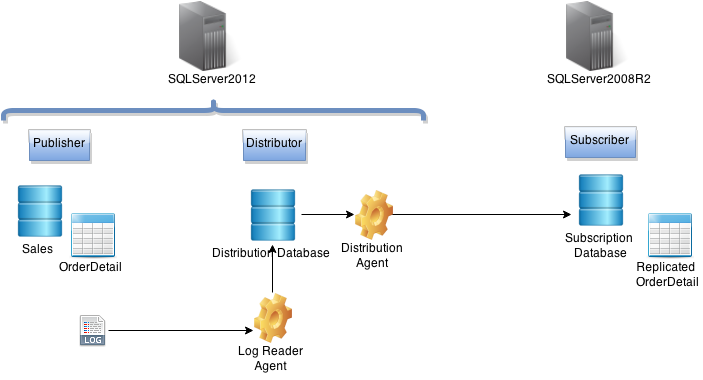
Setting up Sales Database
CREATE DATABASE Sales_Retail
ON PRIMARY
(
NAME=Sales_Retail,
FILENAME='D:\DataSQL2012\Sales_Retail.mdf',
SIZE=5MB,
MAXSIZE=UNLIMITED,
FILEGROWTH=10MB
)
LOG ON
(
NAME = Sales_Retail_log,
FILENAME='D:\DataSQL2012\Sales_Retail_log.mdf',
SIZE=10MB,
MAXSIZE=UNLIMITED,
FILEGROWTH=10MB
);
GO
USE Sales_Retail
GO
CREATE TABLE OrderDetail
(
[SalesOrderID] [int] NOT NULL,
[CarrierTrackingNumber] [nvarchar](25) NULL,
[OrderQty] [smallint] NOT NULL,
[ProductID] [int] NOT NULL,
[SpecialOfferID] [int] NOT NULL,
[UnitPrice] [money] NOT NULL,
[UnitPriceDiscount] [money] NOT NULL,
[LineTotal] AS (isnull(([UnitPrice]*((1.0)-[UnitPriceDiscount]))*[OrderQty],(0.0))),
[rowguid] [uniqueidentifier] ROWGUIDCOL NOT NULL,
[ModifiedDate] [datetime] NOT NULL,
)
GO
-- Insert data
INSERT INTO OrderDetail(SalesOrderID,CarrierTrackingNumber,OrderQty,ProductID,SpecialOfferID,UnitPrice,UnitPriceDiscount,rowguid,ModifiedDate)
VALUES (1,'4911-403C-98',1,776,1,2024.994,0,'B207C96D-D9E6-402B-8470-2CC176C42283','2015-01-01'),
(1,'4911-403C-98',3,777,1,2024.994,0,'7ABB600D-1E77-41BE-9FE5-B9142CFC08FA','2015-01-01')
GOSetting up Distributor
1- Right lick on Replication -> Configure Distributor -> Next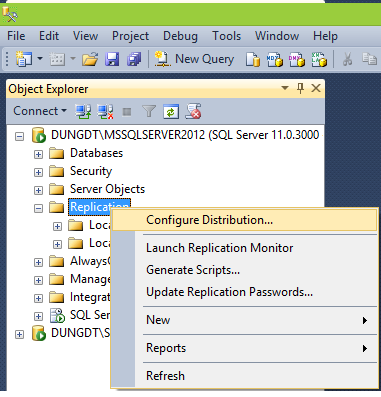 2- Since Distributor and Publisher are on the same server, we will choose the current server-> Next
2- Since Distributor and Publisher are on the same server, we will choose the current server-> Next
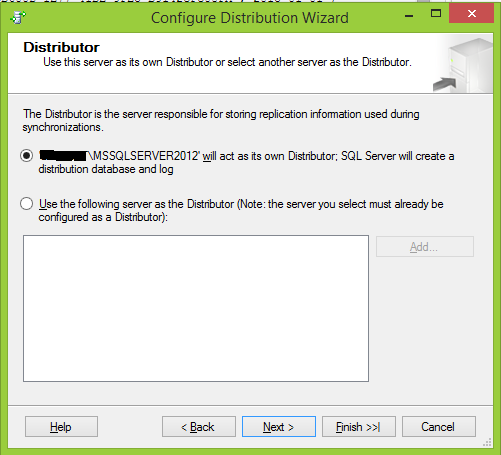 3- Choose No, I will start SQL Server Agent service manually -> Next
3- Choose No, I will start SQL Server Agent service manually -> Next
4- Enter folder for Snapshot folder. This folder will be used for Snapshot Replication type->Next
7- Finish
Setting up Publisher
1- Expand Replication folder, right-click on Local Publication -> New Publication -> Choose Sales_RetailSetting up Subscriber
The next step is to set up the Subscriber instance to receive the replicated OrderDetail table from the Sales_Retail publication instance.1- Connect to the SQLServer2008R2 Instance, expand Replication folder, right-clik on Local Subscriptions and create New Subscriptions -> Next
2- Find SQL Server Publisher -> Connect to the publisher that was created on SQLServer2012 -> Next
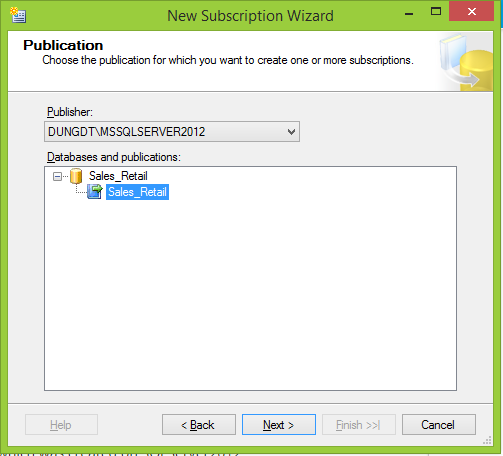 3- Choose the Distribution Agent Location. Depending on your system, you determine on which server to run the agents. For the desmontration purposes, I chose Run all agents at the Distributor, meaning that all agents will run on SQLServer2012.
3- Choose the Distribution Agent Location. Depending on your system, you determine on which server to run the agents. For the desmontration purposes, I chose Run all agents at the Distributor, meaning that all agents will run on SQLServer2012.
6- Synchronization Schedule. You can schedule to synchronize data using
- Run continuouly: run synchronization immediately
- Run on demand only: only run if required
- Define a specific schedule
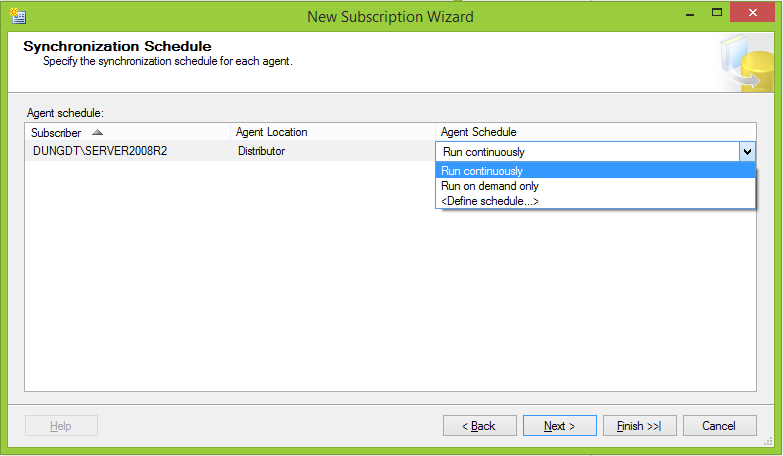
7- Finish
8- Query the data from OrderDetail table on SQLServer2008R2. There are two rows:
INSERT INTO OrderDetail(SalesOrderID,CarrierTrackingNumber,OrderQty,ProductID,SpecialOfferID,UnitPrice,UnitPriceDiscount,rowguid,ModifiedDate)
VALUES (3,'4911-403C-98',1,778,1,2024.994,0,'B207C96D-D9E6-402B-8470-2CC176C42283','2015-01-01'),
(4,'4911-403C-98',3,779,1,2024.994,0,'7ABB600D-1E77-41BE-9FE5-B9142CFC08FA','2015-01-01')
GOExpand Local Publication-> right-click Sales_Retail publication database -> Reinitialize. After that, query data from OrderDetail table on SQLServer2008R2 again. The result is there is 4 rows (two new rows inserted).
![Distributor23.png]() Conclusion
Conclusion
Transaction Replication is appropriate in each of the following cases:
- You want incremental changes to be propagated to Subscribers as they occur.
- The application requires low latency between the time changes are made at the Publisher and the changes arrive at the Subscriber.
- The application requires access to intermediate data states. For example, if a row changes five times, transactional replication allows an application to respond to each change (such as firing a trigger), not simply the net data change to the row.
- The Publisher has a very high volume of insert, update, and delete activity.
- The Publisher or Subscriber is a non-SQL Server database, such as Oracle.
Consider to use Transactional Replication
However, whenever you want to use Transaction Replication you should consider some factors:
- Transaction log space: because Transactional Replication is associated with log files, if size of the log files is large then it will be impact to performance
- Disk space for the distribution database
- Primary keys for each published table: this type always requires that each table must have a primary key
- Trigger
- Large Object data types
Have a question about something in this article? You can receive help directly from the article author. Sign up for a free trial to get started.



Comments (4)
Commented:
You wrote very nice article on Merge replication and transaction replication.
Could you please write articles for snapshot and peer to peer replication.
It would be a great help from you.
Voted Yes this article :)
Author
Commented:Commented:
Commented:
While creating Subscriber-
i got the error : Transaction (Process Id xxx) was deadlocked on lock resources with another process and has been chosen as deadlock victim
I also got the warning : Request to run job....refused because the job is already running from user